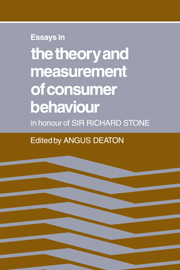Book contents
- Frontmatter
- Contents
- Foreword
- List of contributors
- Part one The analysis of commodity demands
- Introduction
- 1 Some Engel curves
- 2 Suggestions towards freeing systems of demand functions from a strait-jacket
- 3 Theoretical and empirical approaches to consumer demand under rationing
- 4 The independence transformation: a review and some further explorations
- 5 The analysis of consumption and demand in the USSR
- Part two The theory of index numbers
- Part three The consumption function and durable goods
- Part four Other aspects: fertility and labour supply
- Bibliography of Sir Richard Stone's works 1936–79
- Index of names
- Subject index
- Frontmatter
- Contents
- Foreword
- List of contributors
- Part one The analysis of commodity demands
- Introduction
- 1 Some Engel curves
- 2 Suggestions towards freeing systems of demand functions from a strait-jacket
- 3 Theoretical and empirical approaches to consumer demand under rationing
- 4 The independence transformation: a review and some further explorations
- 5 The analysis of consumption and demand in the USSR
- Part two The theory of index numbers
- Part three The consumption function and durable goods
- Part four Other aspects: fertility and labour supply
- Bibliography of Sir Richard Stone's works 1936–79
- Index of names
- Subject index
Summary
In a volume dedicated to Sir Richard Stone, it is appropriate that first consideration should be given to the theory and measurement of commodity demands. Sir Richard's own great monograph, The Measurement of Consumers' Expenditure and Behaviour in the United Kingdom [51] retains its classic status in applied econometrics to this day. The research programme established there and in the 1954 Economic Journal article [48] on the linear expenditure system is still flourishing and the five papers in part one represent several aspects of it.
The first set of topics concern the appropriate choice of functional form for empirical demand equations. In [51], Sir Richard and his coworkers adopted a largely pragmatic approach using a loglinear constant elasticity form. This has great advantages in computation and allows a much more flexible research strategy than is possible with more complex non-linear equations in which all commodities are dealt with simultaneously. However, as has been known for a long time, loglinear demand functions for all commodities are inconsistent with utility theory in that they cannot permit the predicted demands to add up to the predetermined sum of expenditures. This reflects a quite general problem: how do we choose functional forms which are convenient to work with, which allow the easy incorporation of such information as we possess about the nature of individual demands, and which are consistent with the theory? The first two papers in this section are addressed to that question.
- Type
- Chapter
- Information
- Essays in the Theory and Measurement of Consumer Behaviour: In Honour of Sir Richard Stone , pp. 2 - 6Publisher: Cambridge University PressPrint publication year: 1981

